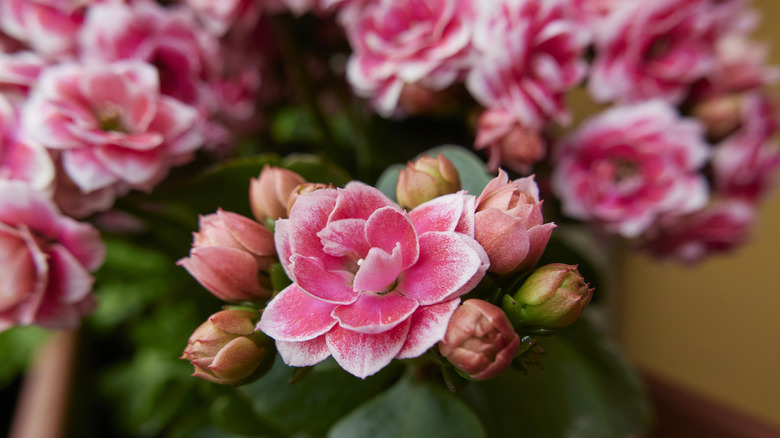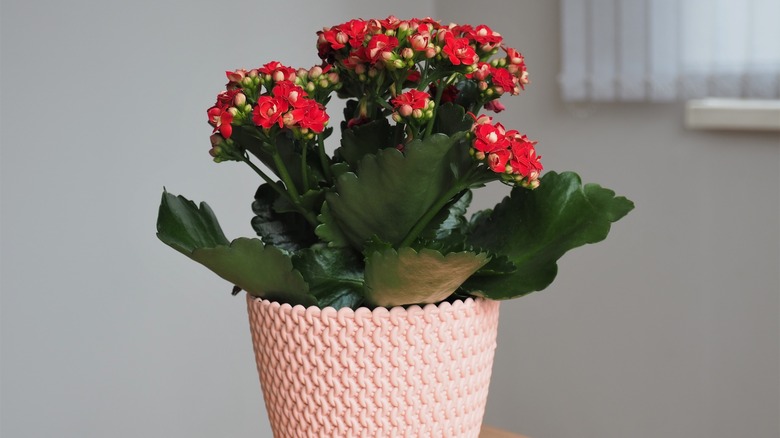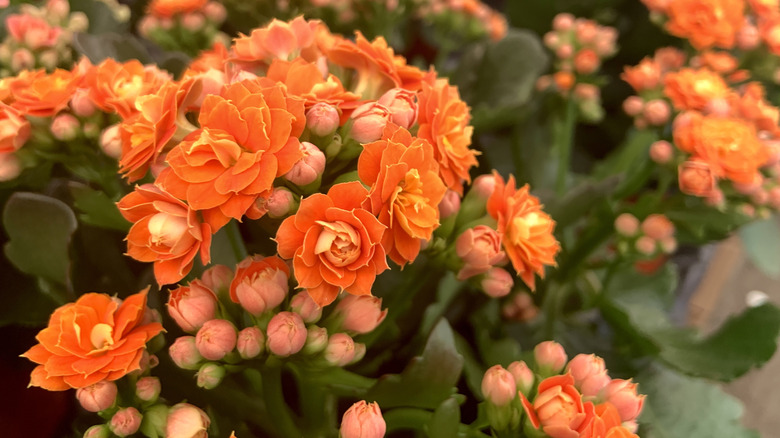How To Care For Beautiful Calandiva Flowers Indoors And Outdoors
When you think of a succulent, what comes to your mind? Maybe you're imagining thick, plump green leaves and a cactus-like appearance. While this is a common succulent presentation, that's not actually the case for the herbaceous perennial succulent called the calandiva, also known by its scientific name Kalanchoe blossfeldiana. This plant features evergreen foliage with tightly wound rosettes that come in shades of scarlet, pink, yellow, or salmon. What's neat about calandiva is that it's not only one of the best succulents to grow indoors, but it can be grown outdoors in USDA zones 10 through 12, too. However, if you're a pet owner, you may want to avoid growing this flowering succulent because it can be toxic to animals.
While some care needs are the same regardless of whether or not you're growing it indoors or outdoors, such as attention to soil type, light levels, and watering amounts, certain requirements will differ depending on the growing location. For instance, outdoor calandiva will be affected by differing light and temperature conditions as the seasons change. Being mindful of these needs allows for your best calandiva flowers and ensures their flowers bloom at their brightest for as long as possible.
How to care for calandiva indoors
Indoor calandiva needs potting soil that is aerated and drains well. For this, you can provide your plant with a blend of 60 percent peat moss and 40 percent perlite. You'll want to thoroughly water indoor calandiva, but only when the soil is slightly dry, since overwatering can harm it. The flowers will also need plenty of sunlight, making them perfect to grow in super sunny spots with indirect light. However, there are certain seasons where less light is better, typically from October to March. Buds form during this time so the plants need shorter days and less light exposure.
When it's naturally dark outside, avoid turning on lights in the rooms your calandiva is located. If you live somewhere with lots of light available, consider placing the plant in a dark room or closet each day from the late afternoon until the following morning. The natural cycle of winter days provides calandiva with 14 to 16 hours of nightfall, for about six weeks — the perfect conditions for the buds to form. Then, flowers grow above the leaves of the plant and calandiva can be placed anywhere, regardless of light exposure. Supplement plant growth, during the growing season with a liquid fertilizer, once a month. Flowers usually blossom by January, if you start the shorter light exposure process in October.
Growing calandiva outdoors
Growing calandiva successfully outdoors depends on your USDA zone since calandiva is sensitive to frost and high winds. It needs to be brought indoors to survive winter in locations cooler than zone 11. In this case, grow calandiva in a pot with sand or perlite in the soil. Alternatively, use a soil blend specifically for cacti and succulents. The plant grows best in climates of 60 degrees Fahrenheit at night and 70 degrees Fahrenheit during the day. Temperatures below 40 degrees Fahrenheit can kill the plant or cause low blooming. However, if you wish to grow calandiva in your garden, they function as perennials in zones 10 and 11, but as annuals in locations north of these zones.
Plant the flowers in well-draining, slightly acidic or neutral soil. Space multiple calandiva 8 to 12 inches apart and grow them in full sun, except for zones 10 and 11 where direct, summer sunshine could scorch the leaves. For these zones, plant in partial shade to account for the short days that calandiva need in the winter and to avoid burning the foliage in the summer. Since calandiva is drought tolerant once established, water the plant once a week or when the soil is dry. Apply granular fertilizer once a month during the growing season. One that's high in phosphorus will promote more blooming.


